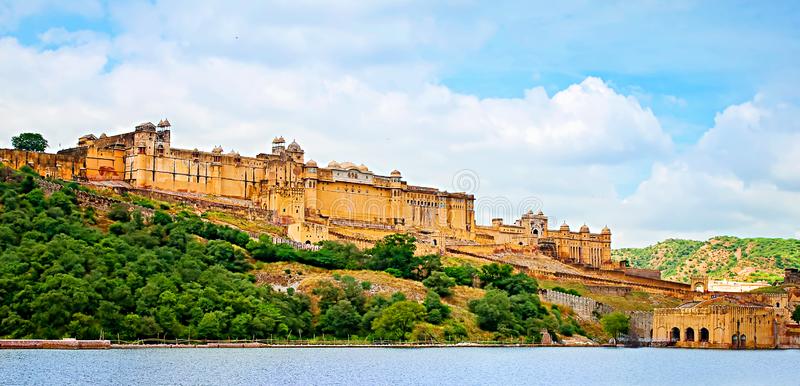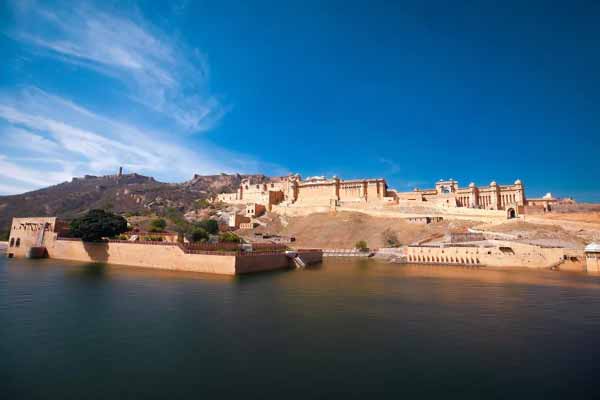Amber Fort Jaipur, also known as Amber Fort locally, is one of the biggest tourist destinations in Jaipur which attracts tourists not just from all parts of India, but from around the world. It is a well-known and highly regarded spot in the whole of Rajasthan and holds great importance in the tourism industry of Jaipur. Any Jaipur tour package is incomplete without spending a good one day at the Amer Fort, which goes by in the blink of an eye. Thousands of tourists visit Amer Fort in Jaipur every day to experience its royal splendour and witness the historical majestic structure.
It is most famous for its elephant rides and the light and sound show in Amer Fort that draws the tourists every day. The fort features large gateways, minute and intricately carvings, royal designs, and other attractions that give it a stately vibe. If you are looking for things to do in Jaipur, then Amer Fort is a great option to spend your day revisiting the past. It gives a peek into the city’s past, its rich culture and undying heritage, and has been inspiring people for years.
Amber Fort Jaipur is one of the oldest forts of Rajasthan and says a lot about the state’s glorious past. It was a gift to Jaipur city by Raja Man Singh I and has been shining magnificently ever since. The fort is a famous historical monument and a reflection of Rajputana style architecture. It has also been included in the UNESCO World Heritage sites, along with five other forts from Rajasthan.

History of the Amber Fort
Raja Alan Singh, who once ruled the Chanda clan of the Meenas, was probably the first king to ever set foot on Amer. He set up his palace on top of the hill, which currently holds the Amber fort, and started to rule over his subjects in the new town. He named his town Khogong. One day, an old woman with a child approached Raja Alan Singh, seeking refuge in his kingdom. The king took them in openheartedly, and even raised the child who was named Dhola Rae.
Dhola Rae was then sent to Delhi to spread the legacy of the Meena kingdom. Instead of obeying his king’s orders, he came back with a small army of his own, which comprised of Rajputs. The Rajputs then slayed everyone belonging to the clad of Meenas, without showing them any sign of mercy. Amber Fort Jaipur It is said that the massacre took place on the day of Diwali, when the Meenas were conducting a special ritual known as ‘Pitra Trapan.’ Back then, it was customary for the Meenas to set aside all their weapons while performing ‘Pitra Trapan.’
The Rajputs, who were aware of this practice, took advantage of the situation and made Khogong their own. This act of theirs was considered as coward and despicable. The town along with the beautiful hill which held the palace like fort now belonged to the Kachwaha Rajputs. Raja Man Singh of the Kachwaha house took over the throne from his predecessor in the early 1600s. He then started building the Amber fort after destroying the structure that was already built on top of the hill. The fort was further developed by the successor of Raja Man Singh, Jai Singh I.
Amber Fort Jaipur Over the next two centuries or so, the fort underwent continuous renovations and improvements under the reign of various Rajput Maharajas including Mirza Raja Jai Singh I. The present fort was completed in the late 16th century. In 1727, the Maharajas of Rajput decided to shift their capital from Amer to Jaipur, leaving no further changes to the appearance of the fort Jaipur Tourism.
Architecture
The architectural style of the fort is a blend of Mughal and Rajput architecture. One of the best examples of this style within the fort is the Ganesh Pol. Mirza Raja Jai Singh, who ruled the place from 1621 to 1627, was instrumental in building the Ganesh Pol. The gate is embellished with mosaics, which makes it look colorful and grand. Among the main attractions of the fort are Jai Mandir and Sheesh Mahal. While the Sheesh Mahal has walls inlaid with exquisite mirrors, the Jai Mandir, hanging on the upper floor, is a superb blend of Mughal and Rajput style of architecture. This is evident from the elegantly carved Jali screens and stucco work.
Jal Mandir has a huge opening which is covered with sandalwood doors. A special feature of this structure is the flow of water through the building, making the entire hall air-conditioned. Sheesh Mahal too, has a special feature. Back then, the entire edifice would glow even at the light of a few candles, such was the architectural brilliance of this specially designed structure. The mirrors used in this palace are convex in nature. It was built during the reign of King Man Singh in the late 1600s Amber Fort Jaipur.
Other major architectural attractions of the fort include the magic flower, palace of Man Singh and the garden. While the magic flower depicts two hovering butterflies, the palace is known for its pavilion. The garden resembles the Chahar Bagh or the famous Mughal Garden. Also, there is a pool which is star-shaped at the center of the garden. Another interesting architectural design of the fort is the fourth courtyard. Since the kings had to visit their queens and mistresses in secret, the courtyard demanded a special design.
It was built in such a way that no one could guess which room the king would enter as the courtyard, with multiple rooms, had a common corridor. The walls of Amber fort are adorned with paintings of hunting and war along with precious stones and mirrors set into the plaster. The Maota Lake at the forefront of the fort gives spectacular and beautiful reflections of the magnificent Amber Fort Jaipur.
Amer Fort Light and Sound Show
The show relives the glorious history of Rajput kings who built this marvellous fort. The entire fort is awash with mesmerising lights at night. The beginning of the show recites the tale of its formation. It goes on to describe how royal kings lived and ruled in the fort.
The story is replete with inspiring stories of grit and grandeur of the Rajput kings. What makes it even more iconic is the signature voice of Amitabh Bachhan as the narrator. The story is beautifully weaved into words by none other than Gulzar Amber Fort Jaipur.
Another remarkable feature of the show is the high-quality HD surround sound that will give you an unforgettable experience. As you sit in the open-air terrace, you’ll be in a trance. The music is composed by great singers like Sultan Khan and Shubha Mangal.
The show runs for one hour approximately and ends at the description of its opening to the Public. The story is available in English as well as Hindi. If you happen to visit the Amer Fort, the show will be an added pearl to the multitude of memories you’ll take with you Amber Fort Jaipur.
How To Reach Amer Fort
The Amber Fort is 11 kilometres away from Jaipur which is the capital of Rajasthan which also is the nearest airport and railway station. Jaipur is readily connected to major parts of the country
Cabs and Taxis are readily available from Jaipur. State buses also ply from the Jaipur and other major cities of the state to Amer. The public buses ply from Ajmeri Gate and MI Road and take around twenty minutes to reach to Amber Fort Jaipur.
